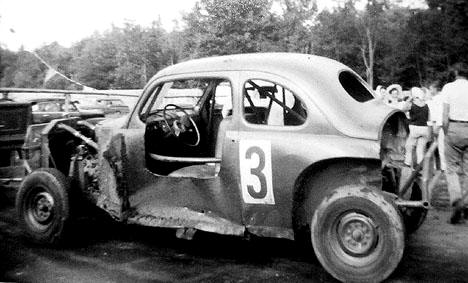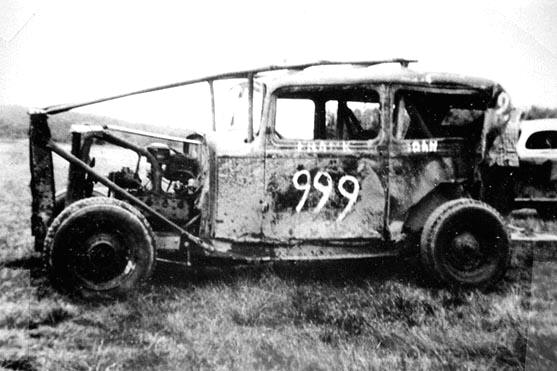
THE
BILL'S BACK IN TIME COLUMN PAGE
Copies of my column in Mark Thomas' "Racin'
Paper"
Column #34 from Column 47
BILL’S BACK IN TIME
By Bill Ladabouche
A REALLY GOOD TRACK WITH A REALLY SHORT LIFE
I just recently completed a round table discussion at the Rutland Historical Society about the long-defunct Pico Raceway track [This was in 2007]. The half mile dirt oval, located South of the city of Rutland, Vermont – in Rutland Town, had a very brief life span. But, the more I learn, the more I realize that Pico was somewhat unique – for stock car tracks in that time and era. Stock car racing, for all intents and purposes, did not exist until after World War II. America was looking for a way to harness its productive and creative energies into something other than military efforts. Then, also, the thousands upon thousands of returning veterans were faced with finding recreational pursuits that fit the modest incomes that so many of them had – at least for a few years after the war.

Post- war racing, at
first, consisted of some pretty crude jalopy racing. This beauty ran at Unity
Speedway, in Maine. [WickedGoodRacing.com Website Photo]
For those who loved motorized machines, the racing of the past was not the answer. Local open wheel racing was limited in availability, and the upper echelons [like Indy] promised to be very expensive – the realm of people like Greek shipping magnate Tassi Vatis and the like. More likely, people in widely varying parts of the country got the same flash of inspiration at the same time: take what was already available and race jalopies. From the jalopies and their cousins, the roofless roadsters, evolved the only – slightly-safer stock car. Although with World War II, production automobiles had thinned out a bit, there were still millions of pre – WWII coupes and sedans [especially Fords and Chevies] sitting idle all over the U.S.. Hundreds of these were deputized into becoming stock car racers. Brace the radiator, add a rollbar or two, paint a number on the side, and maybe add a seat belt – instant race car !

Future
Vermont State Champion and Ken Fenoff built this marvel of engineering for
racing in the
Northeastern corner of Vermont in the early 1950’s. [Ken Paulsen Photo]
The region immediately surrounding Rutland County, Vermont had seen the birth of some race tracks – often using old fairgrounds horse tracks. Tracks were attempted near Hinsdale, New Hampshire and West Brattleboro, Vermont, at the old fairgrounds in Fair Haven, Vermont, the Northfield, Vermont fairgrounds, the Manchester, Vermont fairgrounds, and at the Cheshire Fairgrounds in Keene, New Hampshire. There was even a track built right beside the Rhythm Inn bar, in Millers Falls, Massachusetts – and at countless more sites around the country.
Perhaps the most famous
fairgrounds track to go to stock cars was the one at Fonda, New York. Here, they
are
watering the tracks hours before the show in 1961. [B. Ladabouche Photo]
In my particular area, the closest track was the Fairmont Park Motor Speedway, promoted by the Hugh Young Family on the grounds of the small fairgrounds to the West of Fair Haven, New York [conveniently near the N.Y. border]. In 1950, it was the only show around. However, nearby in Rutland Town, another track was in the incubation stage. If you listen to Ed Fabian, the Pico track was an attempt at giving the local hot rodders a place to legally do their thing; if you listen to C.J. Richards, it was a movement by some Fairmont participants who had an axe to grind with the Fairmont management.
At any rate, Pico was completed in 1951, with a banked half-mile track viewed upon by grandstands located above, on a high sandy bank overlooking the oval. [Unfortunately, the bordering railroad tracks offered another, lower-cost vantage point for the races and dozens used it]. There then proceeded to develop, a rivalry and a competition between the two tracks for the fans and the competitors in the area. Archaic Sunday Blue Laws, which forbade motor events on the Sabbath, made it impossible for the two groups to hold their shows on different days, so the tracks went head – to – head, even with their ads in the local Rutland Herald.
These two ads appeared on the same page, in the same Rutland Herald issue. [Courtesy of John Nelson]
Pico often advertised that they had drawn anywhere from two to four thousand spectators, although caveats in their ads [“Children under 12 must be accompanied by an adult”] suggest that legions of kids, in on free admission, might have been swelling the figures. The Pico ownership triumvirate of Pasquale Romano, a local trucking firm owner; Geno Franzoni, the Rutland Sheriff; and local farmer Abe Newman went for permits for a much broader entertainment facility than just racing. They envisioned rodeos, concerts, and more.
By 1952, Pico’s spectator amenities set it apart from most tracks of its era. By ’52, a high cement wall [that was not altogether popular with the drivers] separated the track surface from the fans. The stands were exceptional for that time, well – constructed wood or aluminum. Lights had been purchased from the defunct Bennington franchise of the Northern Baseball League. The fan area boasted a concession and souvenir stand, as well as good toilet facilities. The track, however, a banked nightmare, was profoundly dusty . The clay, which had been trucked in from nearby Clarendon Springs, was full of rocks, and the banking channeled rainfall into the infield. The infield, which served as the pit area, would become a quagmire frequently.
This photo shows the 1952 Pico infield clearly. [Jerry King Collection]
Pico ended up outdrawing Fairmont and some of its competitors were among the Northeast’s most prominent drivers and teams – coming from Vermont, New Hampshire, Massachusetts, Connecticut, and a few regions of New York. It was not uncommon, in one month, to see: Don Rounds [R.I.]; Buddy Bardwell and Roy Forsythe [N.H.]; Ted Langlois, George Janoski, and Hully Bunn [CT]; Rene Charland and Link Pettit [MA]; Steve Danish, Jeep Herbert, and Spence Parkhurst [N.Y.]; go against Gene Tetrault, Al Romano, Dave Brooks, and Jerry King, from Vermont. Danish may have been the most prestigious of that era.
Legendary even then, Steve Danish and his wife mug for the camera after a Pico race in 1952. [Danish Family Collection]
The fans could put up with the dust, the county could tolerate the noise and traffic, and no one worried that much about the environmental impact in the 1950’s; but, Pico was not particularly good about paying their bills too consistently. In 1953, despite some publicity, the track failed to answer the bell. Plus, competition from nearby Stateline Speedway, Mettawee Speedway, and even far-off Fonda was siphoning off the available competitors, especially the bigger names. Despite plans and efforts, it never ran another race. The beautiful bleachers and the imposing cement wall fell by the wayside; and, today, the site is obliterated by a General Electric plant.
Similar
stories were played out all over – in Vermont and in other regions. The Capital
District of New York, alone, must have had around a dozen different attempts at
tracks; the town of Colchester – in Northern Vermont – had five different
tracks, itself; the area near the Southern Vermont / Northern Massachusetts
border [which was also near Western New Hampshire] had four or five tracks, too.
But few could equal the effort that Pico had put into the infrastructure of
their ill-fated facility.
The only remaining
vestige of Pico is a bit of backstretch and part of Turn 3 – outside the General
Electric plant
fence. [Ladabouche Photo]
Return to the Columns Link Page
Return to the Main News Page